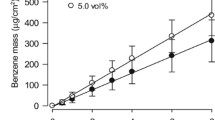Abstract
This paper reports on an experimental study of dermal exposure to neat methanol in human volunteers for the purposes of estimating percutaneous absorption rates, permeation kinetics, baseline (pre-exposure) levels of methanol in blood, and inter- and intrasubject variability. A total of 12 volunteers (seven men and five women) were exposed to methanol via one hand for durations of 0 to 16 min in a total of 65 sessions, making this the largest controlled study of percutaneous absorption for this common solvent. In each session, 14 blood samples were collected sequentially and analyzed for methanol. These data were used to derive absorption rates and delivery kinetics using a two compartment model that accounts for elimination and pre-exposure levels. The pre-exposure methanol concentration in blood was 1.7 ± 0.9 mg l−1, and subjects had statistically different mean concentrations. The maximum methanol concentration in blood was reached 1.9 ± 1.0 h after exposure. Delivery rates from skin into blood lagged exposure by 0.5 h, and methanol continued to enter the systemic circulation for 4 h following exposure. While in vitro studies have reported comparable lag times, the prolonged permeation or epidermal reservoir effect for such miscible solvents has not been previously measured. The mean derived absorption rate, 8.1 ± 3.7 mg cm−2 h−1, is compatible with that found in the other in vivo study of methanol absorption. Both in vivo absorption rate estimates considerably exceed in vitro estimates. The maximum concentration of methanol in blood following an exposure to one hand lasting ∼20 min is comparable to that reached following inhalational exposures at a methanol concentration of 200 ppm, the threshold limit value-time weighted average (TLV-TWA). While variability in blood concentrations and absorption rates approached a factor of two, differences between individuals were not statistically significant. The derived absorption and permeation rates provide information regarding kinetics and absorbed dose that can help to interpret biological monitoring data and confirm mathematical models of chemical permeation.
Similar content being viewed by others
Author information
Authors and Affiliations
Additional information
Received: 11 October 1996 / Accepted: 10 April 1997
Rights and permissions
About this article
Cite this article
Batterman, S., Franzblau, A. Time-resolved cutaneous absorption and permeation rates of methanol in human volunteers. Int Arch Occup Environ Health 70, 341–351 (1997). https://doi.org/10.1007/s004200050228
Issue Date:
DOI: https://doi.org/10.1007/s004200050228




